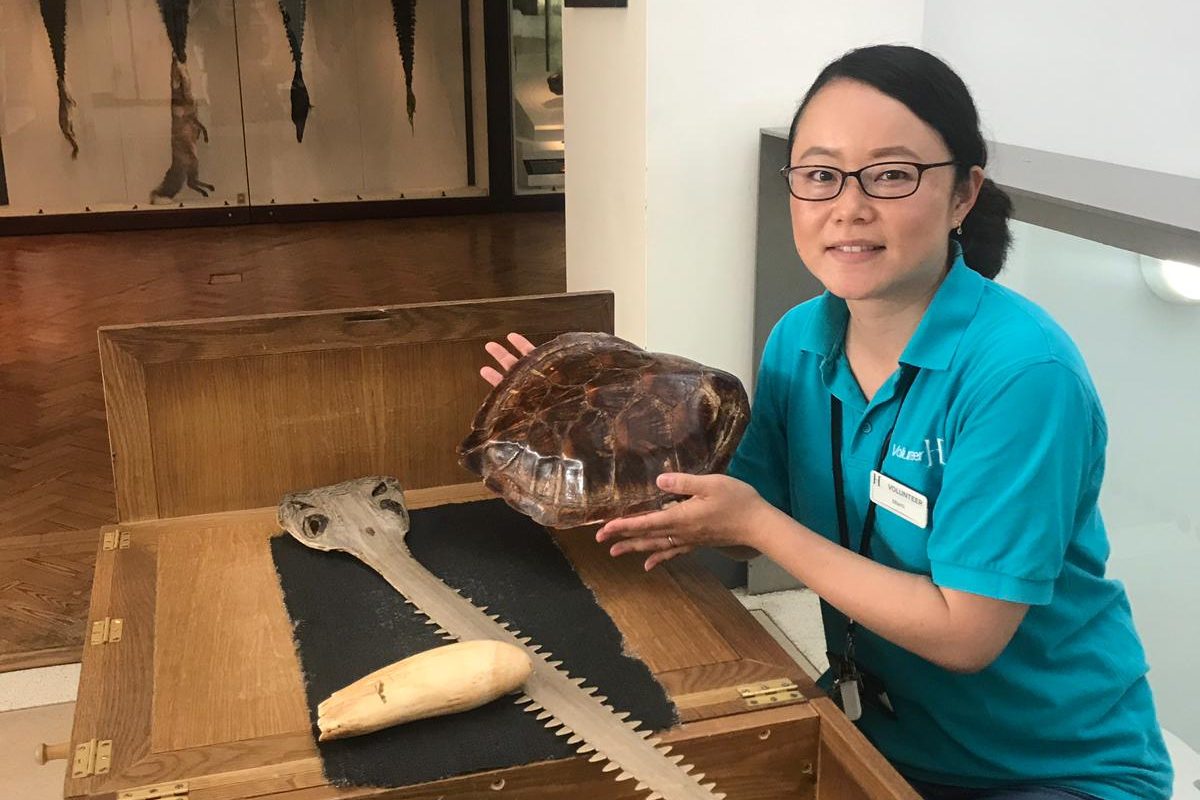Hello, my name is Mami and I moved to the UK from Japan last year. I am a housewife, and my family members are my husband and a shiba-inu dog. I have been volunteering with the Horniman since May 2019. I am really excited to be working for the Horniman, because touching objects is very fascinating. So, I’m pleased to work and learn about the objects and English simultaneously!
I really recommend that you stop by at our touch tables when you are exploring the Horniman. I found it surprising because I had never seen a table like this in Japan. I had never seen a table like this before I came here or touched any museum objects before.
We have several objects: a sawfish, a turtle shell, a sperm whale tooth, a piece of seal skin and a fish skeleton. Today, I’d like to introduce a couple of these handling objects to you and my favourite parts of the Museum.
Sawfish
Sawfish (Anoxupristis caspidata) are a type of ray that are closely related to sharks! They live in shallow coastal waters like bays and estuaries in tropical and subtropical countries. Sawfish like to eat small fish and animals without a spine.
They attack groups of fishes, cutting them into smaller pieces with their saws, making them easier to eat. Surprisingly, they can find food with their rostrum (nose extension) which contain sensory organs! They also use the rostrum as a club to stun the prey or to pin it to the floor before eating it. The rostrum is used as a defensive weapon against strong enemies, using it as a club to stun the prey or pin it to the floor before eating it.
All five species of sawfish are now listed as Endangered or Critically Endangered on the IUCN Red List of Threatened Species. This is because of loss of habitat, plastic and being caught in fishing nets left behind by humans in the sea. They are also facing threats due to plastic pollution caused by us.
Turtle Shell
You are also able to touch the shell of a green turtle. Its scientific name is Chelonia mydas. The shell is hard, like a suit of armour and so tough even a shark’s teeth can’t bite through it! Its shell enables it to swim fast, but unlike many other turtles, the sea turtle can’t pull its head and legs inside its shell to hide from its enemies. Green turtles spend their entire lives at sea and only adult female turtles come ashore when it’s time to lay their eggs.
Sea turtles often drown when caught in fishing gear, nets and long lines. Further to this, they often eat plastic bags because the bags are mistaken for foods such as jellyfish. The plastics remain in their organs and they become to be unable to eat. In the Natural History Gallery, you can see a Green Turtle, currently on loan from the Natural History Museum, London. Its surrounding display highlights the effects facing sea turtles today.
Butterfly House
Lastly, I would like to introduce another attractive display which is my favourite place in the Horniman, the Butterfly House.
You can meet a lot of beautiful butterflies, caterpillars and pupae. They are very friendly, and sometimes they will land on you (but please don’t touch them, sorry and the plants as well). The specially planted tropical garden is kept hot and humid for the butterflies, you may even feel like you are staying at in a tropical area.
I missed Japan when volunteering here, as it is similar to Japans early summer season. Some of the butterflies come from South East and East Asia, including Japan. I would be pleased to show you them if you stopped by.
When I decided to volunteer for the Horniman, it was not only to improve my English, but I also wanted to get involved in a local community. Engaging in voluntary work is best practice for me and I extremely appreciate working here.
Since I started working here, my life in England has grown to be more satisfying than before. At first I was really nervous but now I really enjoy volunteering, because I can work with friendly and lovely co-workers. Whenever I am struggling they always help me. Having lunch with them is the happiest time for me, and one of my favourite times of the day.
As a volunteer, I will really be pleased if I am able to speak English better and speak perfectly when you are visiting, and this motivation always stimulates me to study not only language but also the fascinating objects.
Volunteering is becoming an essential part of my life, and assists in expanding my world in this country. I am gradually building my confidence and enhancing my skills throughout the voluntary work, thanks to my inspirational co-workers and all of the great visitors.
Thank you for reading my blog, and we hope you come and experience our touch tables and fascinating objects. If you are interested in volunteering at the Horniman find out more on the website. We look forward to your visit!




